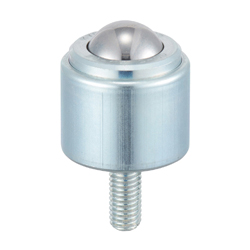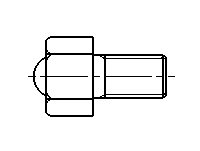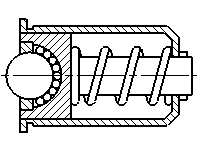(!)NOTE : Windows 7 users won’t be able to use some latest features of eCatalog/WOS since Microsoft is ending support for Windows 7 on 14 Jan, 2020. Please upgrade your system for uninterrupted services.
- Scheduled Maintenance Notice: This site will be unavailable due to scheduled maintenance from 6:30 24/11/2024 to 4:30 (IST) 25/11/2024. We apologize for the inconvenience.
- Please note that the MISUMI Pune office and warehouse will be closed on November 20th due to the state election.
- Notice of End of Sales for Economy Series Pneumatic Equipment Category. More information.
TAKIGEN Ball Rollers(Ball Material:Steel)
Brand |
|
|---|---|
| CAD |
|
| Days to Ship |
|
2 items
- Sort By
-
You can add up to 6 items per a category to the compare list.

TAKIGEN
High-precision steel balls are plentifully employed, designed to withstand long-term use. Unique style due to mechanical design is produced by consistent press work, for strength and wide range of installation methods.
Load Capacity(N) Shape Type Outer Dia. D(Ø) Load Capacity Range(N) Body Material Ball Material 49 ~ 784 Round Threaded Stud / Cylindrical / Flange Standard / Spring-Loaded 20 ~ 96.8 20.1~50.0 / 50.1~100.0 / 100.1~500.0 / 500.1~5000 Steel Steel From: ₹ 374.04 Days to Ship: 5 Day(s) or more  5 Day(s) or more
5 Day(s) or more
-
You can add up to 6 items per a category to the compare list.

TAKIGEN
[Features]
· Machined product, and so can withstand heavy loads.
· Heavy items can also be rotated 360° with low friction coefficient at contact point mechanism.
· K-143-5SNM is ultra-small typeLoad Capacity(N) Shape Type Outer Dia. D(Ø) Load Capacity Range(N) Body Material Ball Material 980 Flange Standard 65 500.1~5000 Steel Steel From: ₹ 3,610.02 Days to Ship: 5 Day(s) or more  5 Day(s) or more
5 Day(s) or more
| Brand |
|---|
| Product Series |
| CAD |
| From |
| Days to Ship |
| Load Capacity(N) |
| Shape |
| Type |
| Outer Dia. D(Ø) |
| Load Capacity Range(N) |
| Body Material |
| Ball Material |
You can add up to 6 items per a category to the compare list. | You can add up to 6 items per a category to the compare list. | |
| Brand | TAKIGEN | TAKIGEN |
| Product Series | ||
| CAD |
|
|
| From | ₹ 374.04- | ₹ 3,610.02 |
| Days to Ship | 5 Day(s) or more | 5 Day(s) or more |
| Load Capacity(N) | 49 ~ 784 | 980 |
| Shape | Round Threaded Stud / Cylindrical / Flange | Flange |
| Type | Standard / Spring-Loaded | Standard |
| Outer Dia. D(Ø) | 20 ~ 96.8 | 65 |
| Load Capacity Range(N) | 20.1~50.0 / 50.1~100.0 / 100.1~500.0 / 500.1~5000 | 500.1~5000 |
| Body Material | Steel | Steel |
| Ball Material | Steel | Steel |
Loading...
Configure
Specification/Dimensions
-
Load Capacity(N)
- 1
- 2
- 4
- 4.9
- 5
- 6
- 7
- 8
- 8.8
- 9.8
- 10
- 11
- 12
- 14
- 14.7
- 19.6
- 19.62
- 21
- 23
- 24
- 27
- 29.4
- 33
- 34
- 41
- 44 (4.5)
- 49
- 49.05
- 49.6 (5)
- 50
- 55
- 62
- 68
- 68.6
- 69
- 78
- 78.4
- 78.48
- 78.5
- 82
- 98
- 98.1
- 107
- 117.6 (12)
- 147
- 157
- 176
- 196
- 196.1
- 196.2
- 216
- 245
- 274 (28)
- 274.4 (28)
- 284
- 294
- 294.2
- 294.3
- 330 (34)
- 343
- 392
- 412
- 470.4 (48)
- 490
- 490.5
- 510
- 588
- 588.6
- 686
- 730
- 784
- 784.5
- 784.8
- 882
- 980
- 1020
- 1056
- 1080
- 1176
- 1176 (120)
- 1180
- 1296
- 1372
- 1470
- 1471.5
- 1510
- 1512
- 1530
- 1568
- 1570
- 1728
- 1764
- 1910
- 1944
- 1960
- 1962
- 2040
- 2160
- 2200
- 2292
- 2320
- 2376
- 2450
- 2548
- 2550
- 2592
- 2640
- 2646
- 2744
- 2800
- 2940
- 2943
- 3020
- 3024
- 3056
- 3060
- 3240
- 3380
- 3430
- 3438
- 3528
- 3570
- 3630
- 3672
- 3680
- 3820
- 3870
- 3920
- 4080
- 4104
- 4116
- 4202
- 4320
- 4410
- 4500
- 4530
- 4536
- 4584
- 4732
- 4900
- 4905
- 5100
- 5150
- 5348
- 5390
- 5400
- 5408
- 5610
- 5730
- 5880
- 6040
- 6084
- 6120
- 6620
- 6750
- 7130
- 7350
- 7550
- 7640
- 8090
- 8112
- 8150
- 8660
- 8788
- 8820
- 9060
- 9120
- 9170
- 9464
- 9560
- 9680
- 9800
- 10140
- 10300
- 10600
- 11000
- 11760
- 11800
- 12100
- 12500
- 13200
- 13600
- 14000
- 14700
- 14872
- 15100
- 16600
- 18100
- 19600
- 21100
- 22600
- 24100
- 25700
- 27200
- 28700
- No
-
Shape
-
Type
-
Outer Dia. D(Ø)
- 8
- 9
- 10
- 11
- 12
- 12.2
- 13
- 15
- 15.8
- 16
- 16.5
- 17
- 18
- 18.5
- 19
- 19.2
- 19.5
- 20
- 20.5
- 21
- 22
- 23
- 24
- 25
- 25.7
- 25.8
- 26
- 27
- 27.5
- 28
- 29
- 30
- 31
- 32
- 33
- 34
- 34.5
- 35
- 36
- 38
- 39
- 39.5
- 41
- 41.3
- 42
- 44
- 45
- 46
- 47
- 48
- 50
- 50.2
- 51
- 51.5
- 52
- 53
- 55
- 55.5
- 55.8
- 56
- 57
- 58
- 59.3
- 60
- 65
- 65.2
- 66
- 67
- 69
- 70
- 71
- 71.8
- 72
- 75
- 76
- 77
- 78
- 80
- 85
- 88
- 95
- 96
- 96.8
- 100
- 107
- 110
- 120
- 130
- 140
- 151.2
- 155
- 180
- 187
- 200
- 304
- 401
- 456
- No
-
Load Capacity Range(N)
- 1.0~10.0
- 10.1~20.0
- 20.1~50.0
- 50.1~100.0
- 100.1~500.0
- 500.1~5000
- 5000.1~10000
- 10000.1~20000
- 20000.1 or more
-
Body Material
- Steel
- Stainless Steel
- Plastic
- Aluminum
-
Ball Material
- Steel
- Stainless Steel
- Plastic
Narrow search by specifying Manufacturer
-
- MISUMI (6)
- FREEBEAR (28)
- IGUCHI KIKO (19)
- ATEC (12)
- MAKITECH (2)
- TAKIGEN (2)
- TRUSCO NAKAYAMA (2)
- FUJI SEISAKUSHO (0)
Related Categories to Ball Rollers
FAQ Ball Rollers
- Question: What is a ball roller and how does it work?
- Answer: A ball roller , also known as a ball transfer unit, is a device used in material handling applications to facilitate the movement of objects. It consists of multiple small ball bearings held within a housing. The balls are designed to rotate freely, allowing objects to be smoothly transferred or rotated in any direction.
- Question: What are the advantages of using ball rollers in material handling applications?
- Answer: Ball roller offer several advantages in material handling applications. They provide a low-friction surface, enabling easy and smooth movement of objects. Ball transfers allow for multidirectional movement, making them suitable for applications that require quick and efficient changes in direction. They are also durable, capable of handling heavy loads, and can be easily integrated into conveyor systems or workstations.
- Question: What types of ball rollers are available?
- Answer: Conveyor ball rollers: These are commonly used in conveyor systems to transport goods or materials along a predetermined path.
Ball transfer units: These are individual units with multiple balls arranged in a housing, allowing objects to be easily rotated or moved in any direction.
Heavy-duty ball rollers: Designed to withstand higher loads and harsher operating conditions, these rollers are commonly used in industrial settings. - Question: How do you select the right type of ball roller for your specific application?
- Answer: When selecting a ball roller , consider factors such as the weight and size of the objects being transferred, the operating environment, and the desired movement flexibility. It is important to choose a ball transfer with a load capacity that meets your application requirements. Consulting with a supplier or engineer can help determine the appropriate type and specifications for your specific needs.
- Question: What are the different materials used to make ball rollers and how do they affect performance?
- Answer: Ball roller can be made from various materials, including steel, stainless steel, and plastic. Steel ball transfers offer high load capacity and durability, making them suitable for heavy-duty applications. Stainless steel transfers are corrosion-resistant and ideal for environments with moisture or harsh chemicals. Plastic transfers are lightweight and non-corrosive, suitable for lighter loads and quieter operation. The choice of material depends on factors such as load capacity, operating conditions, and specific application requirements.



















How can we improve?
How can we improve?
Thank you for your time.
Your feedback is essential for our continuous improvement
Privacy Policy
Thank you for your cooperation.
Thank you for your time.
Your feedback is essential for our continuous improvement
Please use the inquiry form.
Privacy Policy